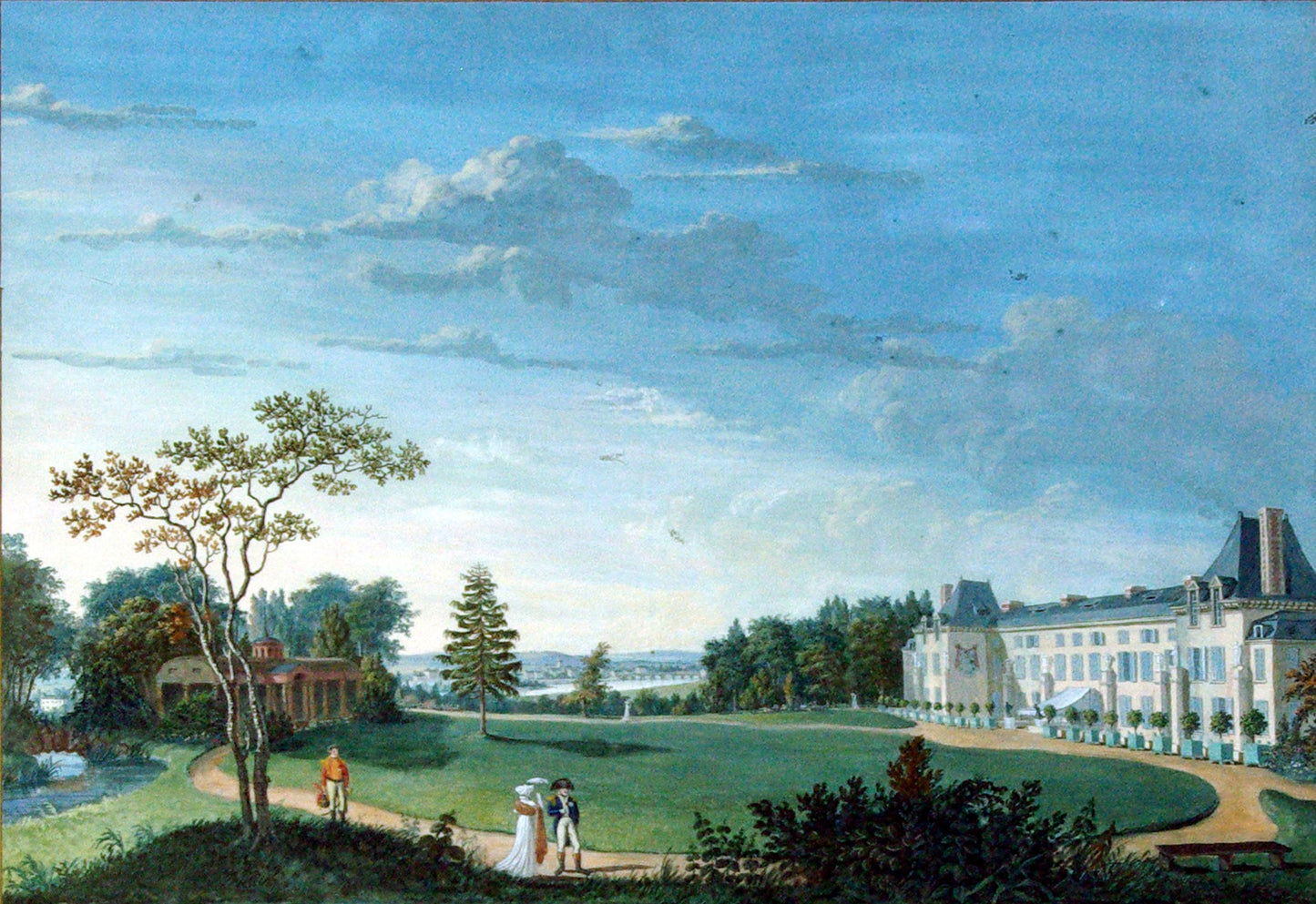Mongin, Pierre Antoine (attr.). View of the Gardens and Facade of the Chateau de Malmaison, near Paris, with Napoleon and Josephine strolling in the foreground. After 1799.
Mongin, Pierre Antoine (attr.). View of the Gardens and Facade of the Chateau de Malmaison, near Paris, with Napoleon and Josephine strolling in the foreground. After 1799.
Couldn't load pickup availability
Attributed to Antoine Pierre Mongin
View of the Gardens and Facade of the Château de Malmaison, near Paris, with Napoleon and Josephine strolling in the foreground
Gouache over black chalk, after 1799
18 7/8" x 26 1/2"
Exhibition history: “Public Parks, Private Gardens: Paris to Provence”, Metropolitan Museum of Art, NY, March 12 - July 19, 2018 (exhibition label attached on the back of the frame)
Interestingly, according to wallpaper authority Ed Polk Douglas, Mongin was responsible for the design of some of the Zuber Company's most important scenics, often seen in American homes: "Views of Switzerland(1804)"; "Hindustan(1807)"; "Views of Italy(1818)"; and ""French Gardens(1822)".
Attributed to Antoine-Pierre Mongin (1761-1827) the present View of the Gardens and Facade of the Chateau de Malmaison is remarkable not only for its accomplished use of gouache paint- in itself a hard-to-master medium - but also for its subtle transcending the boundaries of landscape scenes. It was exhibited at the Metropolitan Museum of Art’s 2018 show “Public Parks, Private Gardens: Paris to Provence'' where it occupied a central position in its dual characteristics of being a private or essentially intimate view of a public setting. Herein lies much of its effectiveness.
Indeed, by introducing the strolling figures of Napoleon and his wife Josephine, Mongin elevates their status from mere staffage to the hidden protagonists of the painting. Indeed, he inverts the hierarchy governing the compositional setup of the landscape tradition as inherited from the Baroque tradition of Poussin, Claude, and others.
The staffage figures are not meant to serve the general aesthetics of the scene, but rather the other way around: the idyllic setting of Malmaison and its gardens gain their significance from the presence of Napoleon and Josephine. This makes the present view with its reduced dimensions of only 18 7/9 x 26 1/2 inches an intimate piece that was executed for the Empress herself.
An old label on the verso suggests this connection by stressing Josephine’s ownership of Malmaison: “Le Chateau de Malmaison appartenant à l'Impératrice.” Josephine Bonaparte had purchased the palace which is located only eight miles west of Paris in 1799. Having spent 225,000 francs on the premises, a far greater sum would be needed for the decoration and furnishing of the house, including the beautification of the gardens.
The gardens allowed the Empress to indulge her love for botany and her role as a patron to master painter Joseph Pierre Redoute immediately comes to mind. Indeed, she began a collection of flowers and plants which included examples from her family’s estate in the West Indies, Kew Gardens in England and the Jardin des Plantes in Paris. Along with the almost two hundred new species grown on the estate, the garden was famed for containing over two hundred and fifty varieties of roses. Mongin thus gives a rare glimpse into both the private life of Josephine and the appearance of Malmaison and its gardens before they fell into disrepair at the Empress’ death. The pavilion in the painting’s background can still be seen today.
Antoine-Pierre Mongin thus created a “paysage historié” - analogous to the established hybrid of the “portrait historié”. It gains its significance through its connection with historical figures; on a formal plan, this connection is realized through the interplay of colors and Josephine's Ownership of Malmaison, for example, is demonstrated by according the pale blue of her robe to the general tone of the house and its awning.
Mongin, who studied at the Académie des Beaux-Arts in Paris and exhibited at the Salon Between 1791 and 1824, is represented in the collections of major European and American Institutions. Rarely though is his touch more painterly and subtle than in the present view of Malmaison which remains an intimate masterpiece of the French Empire.


